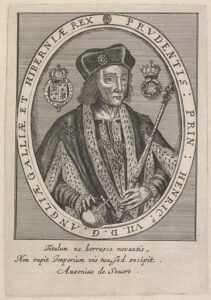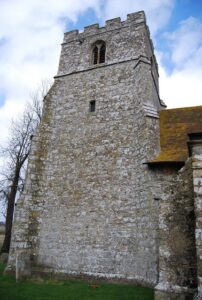Our Lent series on Romney Marsh churches visits St Dunstan’s in Snargate. A church with a unique connection to the navy and a royal visit to Rye.
Why did King Henry VII visit Rye in 1488? We know that when the mayor, Adam Oxenbridge, entertained the King in that year, it is believed to have been in his newly built house, now known as Watchbell Chambers. Certainly the early monarchs were frequently in our area as Winchelsea had been one of the major Royal embarkation ports. Having read about Henry’s visit when researching the history of Watchbell Street, further digging has unearthed what I believe is probably at least part of the reason for the regal visitation. The key to that may be in a church a few miles from Rye, St. Dunstan’s in Snargate, on Romney Marsh.
In 1488, King Henry was not absolutely secure on his throne. He had defeated the last Plantagenet king, Richard III, at the Battle of Bosworth in 1485. There were, however, threats to his rule, even from overseas, where France was still our enemy. Additionally, the Duchy of Britanny was not friendly. When Henry had been just an exile at the Breton court, a marriage between him and Anne of Britanny was proposed, but she was not willing to marry him. Why would she? His ancestry was questionable, his prospects were then not enticing, and physically, neither was he. One contemporary described him as having a sallow countenance, straggly hair and not many teeth.
Whatever his physical characteristics, Henry was a firm believer in the importance of ruling the sea. He ordered merchant ships, improved the royal dockyards and, in 1495, commissioned the earliest dry dock to have survived, in Portsmouth. Two ships were built there for him. When he became king there were just seven royal ships. He bought some, captured at least one and built at least four warships.

During his reign, Henry commissioned in total about 40 ships, naval and merchant, some of which were built locally at Smallhythe. However, there was a further quite important shipyard in the same area, just a few miles from Tenterden. This was Reding (or Reading Street, names vary.) We know that King Henry paid a visit here, in August 1487 to see how his new ship, the 600 ton Regent was progressing. Another ship, Sovereign, was also built there for Henry.
Both Regent and Sovereign were described as Carracks, a type of ship rarely found in England. They were relatively sophisticated vessels, and very expensive, probably in the region of £5,000. They were fitted with four masts, two of them, main and fore, fitted with topcastles, platforms from which to fight and see what was happening. Some of the sails faced forwards, whilst the rear masts had triangular sails like a modern sailing yacht. At the bow was a two level forecastle, and the stern a three or four level aftercastle. Despite that, the forecastle stood taller than the sterncastle, a typical carrack feature. The Regent was armed with something like 225 cannon, including small ones on swivels on the rails, to decimate an opposing crew. About 190 cannon were housed in the fore and stern castles, with the remainder in the waist (the area between the castles,) and the stern.
The hull of Regent was launched in 1488, and towed down the River Rother around to Rye, then a royal dockyard, to be fitted with its masts and necessary rigging. This important event was, I think at least partially, why King Henry was in Rye that year. It would be natural for him to visit to see the latest addition to his fleet. It is also likely that he wanted to find out if he could rely on the loyalty and capability of the Cinque Ports. He arrived in Rye via Lewes and Battle and was in town for just one day in August. He also visited the dockyard at Reding and then went on to Winchelsea.
Henry was offered an entertainment at the house of Adam Oxenbridge. At dinner the dishes offered included locally caught turbot, and whilst eating the party was serenaded by minstrels. The total cost to the borough was £2,18 shillings and 11 pence, which included paying a man to remove dung.
The fitting out was finished early in 1490, and Regent was commissioned in July. It was rarely used in anger. In 1512, early in the reign of King Henry VIII, it was involved in the Battle of Saint-Mathieu near the French port of Brest. Most of the French and Duchy of Britanny ships headed back to port, with just three staying to fight the English fleet. Whilst engaged in a three hour close battle with a Duchy of Britanny carrack, Cordelière, both ships caught fire and exploded. Locked together with their masts and rigging, they sank quickly, taking hundreds of men to the bottom with them, amongst them members of some of England’s noble families.

Back to St. Dunstan’s. During restoration work in the 1960s, when a layer of whitewash was removed from a wall on the north side of the church, a large painting of a ship was uncovered, about two metres wide. Such paintings were at one time said to indicate a safe hiding place for a smuggler’s contraband. Its originally red paint had changed colour over time to something more like that fashionable decorating colour, terracotta. It seems to date from the late 15th to the early 16th century and has the appearance of a carrack.
Although clearly the work of an amateur, it is well and accurately painted, indicating that the artist had at least some knowledge of shipbuilding. It corresponds to much of what is known about Regent; there are three levels to the aftercastle, its style of rigging corresponds to what is known to have been used on her, and the number of ports for the cannon in the castles seems to match those described on Regent. Snargate is close to where Regent was built and it is known that shipbuilders lived locally. Although impossible to say for certain that the ship in the painting is Regent, it is possible. After all it was an important vessel, so perhaps a painting in a church was thought to be a way for it to be sanctified and protected? If the association could be proved, then it would be the oldest picture of a known ship in England.
The king’s visit to Rye was evidently successful for the town, with the cost of entertaining him an excellent investment. Within no more than three months, the mayor was put in charge of customs for much of the south coast, and made head of a government commission on shipping in the Channel. Interestingly, Oxenbridge was a lawyer, with no seafaring experience.
With thanks to Trevor Llanwarne, for his useful information about the details of the king’s visit.
Image Credits: User:Marco2000/World history encyclopeadia https://www.worldhistory.org/image/12405/madre-de-deus-model/ CC https://creativecommons.org/licenses/by/4.0/, Yale Centre for British Art https://www.lookandlearn.com/history-images/YYA0034441/Henry-VII CC https://creativecommons.org/publicdomain/zero/1.0/, N Chadwick/Geograph https://www.geograph.org.uk/photo/1746086 CC https://creativecommons.org/licenses/by-sa/2.0/.




Fascinating. Thank you!